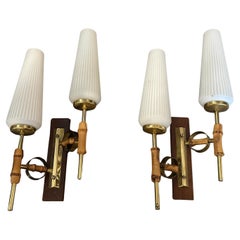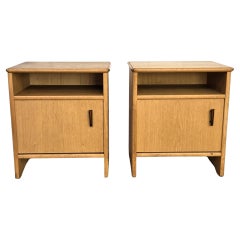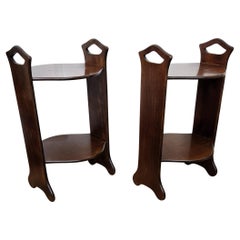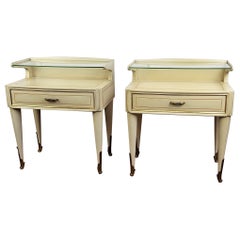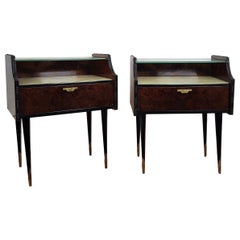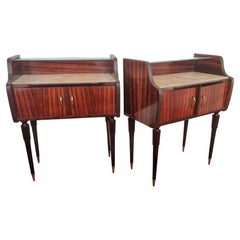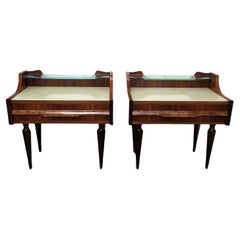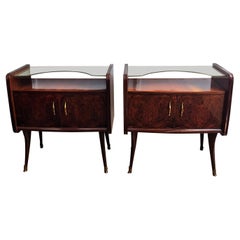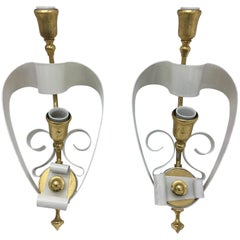1950s Midcentury Bed
Mid-20th Century Italian Mid-Century Modern Wall Lights and Sconces
Brass
Mid-20th Century Italian Mid-Century Modern Side Tables
Brass
Mid-20th Century Italian Mid-Century Modern Side Tables
Wood
Mid-20th Century Italian Art Deco Side Tables
Brass
Mid-20th Century Italian Art Deco Side Tables
Brass
Mid-20th Century Italian Art Deco Side Tables
Brass
Mid-20th Century Italian Mid-Century Modern Side Tables
Brass
Mid-20th Century Italian Art Deco Side Tables
Brass
Mid-20th Century Italian Mid-Century Modern Wall Lights and Sconces
Iron, Brass
Mid-20th Century American Mid-Century Modern Beds and Bed Frames
Maple
Vintage 1950s Italian Mid-Century Modern Beds and Bed Frames
Bamboo
Vintage 1950s Brazilian Mid-Century Modern Beds and Bed Frames
Leather, Hardwood
Vintage 1950s Italian Mid-Century Modern Beds and Bed Frames
Metal
Mid-20th Century Italian Mid-Century Modern Beds and Bed Frames
Glass, Walnut
Vintage 1950s Italian Mid-Century Modern Beds and Bed Frames
Bamboo
Vintage 1950s Italian Mid-Century Modern Beds and Bed Frames
Bamboo
Vintage 1960s Italian Mid-Century Modern Beds and Bed Frames
Wood
Vintage 1950s Beds and Bed Frames
Bamboo
Vintage 1950s English Mid-Century Modern Beds and Bed Frames
Walnut
Vintage 1950s French Mid-Century Modern Beds and Bed Frames
Elm
Vintage 1950s Italian Mid-Century Modern Beds and Bed Frames
Wood, Maple, Plywood, Paint
Vintage 1950s French Mid-Century Modern Beds and Bed Frames
Metal
Vintage 1950s French Mid-Century Modern Beds and Bed Frames
Metal
Vintage 1950s French Mid-Century Modern Beds and Bed Frames
Metal
Vintage 1950s Dutch Mid-Century Modern Beds and Bed Frames
Metal
Mid-20th Century Dutch Mid-Century Modern Beds and Bed Frames
Metal
Vintage 1950s Italian Mid-Century Modern Beds and Bed Frames
Walnut, Wood
20th Century Italian Mid-Century Modern Beds and Bed Frames
Wood, Parchment Paper
Mid-20th Century Dutch Mid-Century Modern Beds and Bed Frames
Metal
Mid-20th Century Dutch Mid-Century Modern Beds and Bed Frames
Metal
Vintage 1950s Dutch Mid-Century Modern Beds and Bed Frames
Metal
Vintage 1950s Italian Mid-Century Modern Beds and Bed Frames
Brass
Vintage 1950s Italian Mid-Century Modern Beds and Bed Frames
Metal, Brass
Vintage 1950s Brazilian Mid-Century Modern Beds and Bed Frames
Iron, Brass
Vintage 1950s Italian Mid-Century Modern Beds and Bed Frames
Bronze
Vintage 1950s Italian Mid-Century Modern Beds and Bed Frames
Wood, Burl
Vintage 1950s Italian Mid-Century Modern Beds and Bed Frames
Mahogany
Vintage 1950s Italian Mid-Century Modern Beds and Bed Frames
Macassar, Maple, Rosewood, Burl
Vintage 1950s Italian Mid-Century Modern Beds and Bed Frames
Metal, Bronze
Vintage 1950s French Mid-Century Modern Beds and Bed Frames
Elm
Vintage 1950s Italian Mid-Century Modern Bed Coronas
Bamboo, Faux Bamboo
Vintage 1950s Italian Mid-Century Modern Beds and Bed Frames
Glass, Maple, Parchment Paper
Vintage 1950s French Mid-Century Modern Beds and Bed Frames
Metal
Vintage 1950s French Mid-Century Modern Beds and Bed Frames
Metal
Vintage 1950s French Mid-Century Modern Beds and Bed Frames
Metal
Vintage 1950s American Mid-Century Modern Beds and Bed Frames
Mahogany
Vintage 1950s American Mid-Century Modern Beds and Bed Frames
Mahogany
Vintage 1950s American Mid-Century Modern Beds and Bed Frames
Cane, Mahogany
Vintage 1950s Italian Mid-Century Modern Bed Coronas
Plywood
Vintage 1950s American Mid-Century Modern Beds and Bed Frames
Brass
Vintage 1950s French Mid-Century Modern Beds and Bed Frames
Cherry
Vintage 1950s Italian Mid-Century Modern Beds and Bed Frames
Upholstery, Wood
Vintage 1950s Italian Mid-Century Modern Bed Coronas
Bamboo, Straw
Vintage 1950s French Mid-Century Modern Table Lamps
Bronze
Vintage 1950s Italian Mid-Century Modern Canapes
Iron
Vintage 1950s German Mid-Century Modern Wall Lights and Sconces
Metal, Brass
Vintage 1960s Dutch Mid-Century Modern Wall Lights and Sconces
Metal
Mid-20th Century French Wall Lights and Sconces
Metal, Brass
Mid-20th Century Italian Mid-Century Modern Tray Tables
Laminate, Wood
Vintage 1950s Italian Mid-Century Modern Tray Tables
Plastic, Laminate, Wood, Beech
- 1
1950s Midcentury Bed For Sale on 1stDibs
How Much is a 1950s Midcentury Bed?
A Close Look at Mid-century Modern Furniture
Organically shaped, clean-lined and elegantly simple are three terms that well describe vintage mid-century modern furniture. The style, which emerged primarily in the years following World War II, is characterized by pieces that were conceived and made in an energetic, optimistic spirit by creators who believed that good design was an essential part of good living.
ORIGINS OF MID-CENTURY MODERN FURNITURE DESIGN
- Emerged during the mid-20th century
- Informed by European modernism, Bauhaus, International style, Scandinavian modernism and Frank Lloyd Wright’s architecture
- A heyday of innovation in postwar America
- Experimentation with new ideas, new materials and new forms flourished in Scandinavia, Italy, the former Czechoslovakia and elsewhere in Europe
CHARACTERISTICS OF MID-CENTURY MODERN FURNITURE DESIGN
- Simplicity, organic forms, clean lines
- A blend of neutral and bold Pop art colors
- Use of natural and man-made materials — alluring woods such as teak, rosewood and oak; steel, fiberglass and molded plywood
- Light-filled spaces with colorful upholstery
- Glass walls and an emphasis on the outdoors
- Promotion of functionality
MID-CENTURY MODERN FURNITURE DESIGNERS TO KNOW
- Charles and Ray Eames
- Eero Saarinen
- Milo Baughman
- Florence Knoll
- Harry Bertoia
- Isamu Noguchi
- George Nelson
- Danish modernists Hans Wegner and Arne Jacobsen, whose emphasis on natural materials and craftsmanship influenced American designers and vice versa
ICONIC MID-CENTURY MODERN FURNITURE DESIGNS
- Eames lounge chair
- Nelson daybed
- Florence Knoll sofa
- Egg chair
- Womb chair
- Noguchi coffee table
- Barcelona chair
VINTAGE MID-CENTURY MODERN FURNITURE ON 1STDIBS
The mid-century modern era saw leagues of postwar American architects and designers animated by new ideas and new technology. The lean, functionalist International-style architecture of Le Corbusier and Bauhaus eminences Ludwig Mies van der Rohe and Walter Gropius had been promoted in the United States during the 1930s by Philip Johnson and others. New building techniques, such as “post-and-beam” construction, allowed the International-style schemes to be realized on a small scale in open-plan houses with long walls of glass.
Materials developed for wartime use became available for domestic goods and were incorporated into mid-century modern furniture designs. Charles and Ray Eames and Eero Saarinen, who had experimented extensively with molded plywood, eagerly embraced fiberglass for pieces such as the La Chaise and the Womb chair, respectively.
Architect, writer and designer George Nelson created with his team shades for the Bubble lamp using a new translucent polymer skin and, as design director at Herman Miller, recruited the Eameses, Alexander Girard and others for projects at the legendary Michigan furniture manufacturer.
Harry Bertoia and Isamu Noguchi devised chairs and tables built of wire mesh and wire struts. Materials were repurposed too: The Danish-born designer Jens Risom created a line of chairs using surplus parachute straps for webbed seats and backrests.
The Risom lounge chair was among the first pieces of furniture commissioned and produced by celebrated manufacturer Knoll, a chief influencer in the rise of modern design in the United States, thanks to the work of Florence Knoll, the pioneering architect and designer who made the firm a leader in its field. The seating that Knoll created for office spaces — as well as pieces designed by Florence initially for commercial clients — soon became desirable for the home.
As the demand for casual, uncluttered furnishings grew, more mid-century furniture designers caught the spirit.
Classically oriented creators such as Edward Wormley, house designer for Dunbar Inc., offered such pieces as the sinuous Listen to Me chaise; the British expatriate T.H. Robsjohn-Gibbings switched gears, creating items such as the tiered, biomorphic Mesa table. There were Young Turks such as Paul McCobb, who designed holistic groups of sleek, blond wood furniture, and Milo Baughman, who espoused a West Coast aesthetic in minimalist teak dining tables and lushly upholstered chairs and sofas with angular steel frames.
Generations turn over, and mid-century modern remains arguably the most popular style going. As the collection of vintage mid-century modern chairs, dressers, coffee tables and other furniture for the living room, dining room, bedroom and elsewhere on 1stDibs demonstrates, this period saw one of the most delightful and dramatic flowerings of creativity in design history.
- 1stDibs ExpertApril 5, 2022Yes. While the gem has always been a mainstay in jewelry, there was a boom in demand for pearl pieces in the 1950s. The style at the time was black-and-white-chic, and pearls were an excellent accompaniment to pieces like the classic little black dress. Shop a collection of expertly vetted pearl jewelry from some of the world’s top sellers on 1stDibs.
- What is 1950s furniture called?1 Answer1stDibs ExpertSeptember 23, 20241950s furniture is called vintage furniture. Some pieces produced during this period may be considered mid-century modern based on their characteristics. Mid-century modern design refers to the variety of modernism that rose to prominence in the 1940s and ’50s. It displays many of the characteristics of the earlier versions of modernism, including simple forms and a focus on functionality. Other traits common in mid-century modern furniture include unadorned silhouettes, clean lines and mixed materials, emphasizing wood, wool, steel and plastic. On 1stDibs, explore a large collection of 1950s furniture.
- 1stDibs ExpertJune 30, 2023Some popular watches for men during the 1950s were the Rolex Submariner, the Enicar Sherpa Dive, the Breitling Navitimer, Omega, Constellation and the Rolex GMT-Master. Rolex, Timex, Orvin, Tower and Elgin were among the top watchmakers for women during the decade. On 1stDibs, find a collection of antique, vintage and contemporary watches.
- 1stDibs ExpertFebruary 21, 2024The clothing style in the 1950s was well tailored and classic. For women, dresses with padded busts, cinched waists and hips, and full circle skirts were popular, and the collared button-up shirt dress came into fashion during the decade. Men tended to wear suits in neutral gray, dark blue and brown colors made out of easy-to-care-for synthetic fabrics. Straight-cut double-breasted blazers were commonly worn for casual occasions. On 1stDibs, explore a variety of vintage clothing from the 1950s.
- 1stDibs ExpertNovember 21, 2023In the 1950s, several diamond cuts were popular. They included the brilliant round cut, the Asscher cut, the emerald cut and the marquise cut. Rings that featured a large central stone flanked by smaller baguettes were also trendy during the decade. Find a collection of vintage diamond jewelry on 1stDibs.
- 1stDibs ExpertNovember 13, 2024The best-known 1950s furniture style is called mid-century modern. Organically shaped, clean-lined and elegantly simple are three phrases that describe vintage mid-century modern furniture. The style emerged primarily in the years following World War II through creators who believed that good design was an essential part of good living. Mid-century modern designers combined natural and human-made materials, such as teak, rosewood and oak woods as well as steel, fiberglass and molded plywood. Some well-known mid-century modern designers include Charles and Ray Eames, Eero Saarinen, Milo Baughman, Florence Knoll, Harry Bertoia, Isamu Noguchi and George Nelson. On 1stDibs, shop a large selection of mid-century modern furniture.
- 1stDibs ExpertNovember 6, 2023There were a few popular diamond cuts in the 1950s. One was the brilliant round cut, which is still common today due to its simple shape and prominent sparkle. Other favorite cuts of the decade included the Asscher cut, the emerald cut and the marquise cut. On 1stDibs, explore a large selection of engagement rings.
- 1stDibs ExpertNovember 27, 2023In the 1950s, a Chanel bag was priced between $200 and $300. The iconic Chanel 2.55 bag cost $220 when first introduced in February 1955. Accounting for inflation, that works out to around $2,536 in today's money. On 1stDibs, find a diverse assortment of Chanel bags from some of the world's top boutiques.
- Which artist became famous for his series of black paintings in the late 1950s and early 1960s?1 Answer1stDibs ExpertJanuary 27, 2025Frank Stella is the artist who became famous for his series of black paintings in the late 1950s and early 1960s. These works featured bands of black paint separated by thin, precise stripes of bare canvas. At a time when contemporary painting was all about wild gestures, thick paint and formal abandon, the “Black Paintings” created a sensation. Explore a range of Frank Stella art on 1stDibs.
Read More
This Paavo Tynell Chandelier Is a Radiant Bouquet
The alluring pendant light exemplifies the designer’s winsome mid-career work.
End Your Quest for Fire with This Handmade Majolica Chimney
Prehistoric motifs give the mid-century Italian fireplace an elemental feel.
Who Were Guillerme et Chambron? French Veterans of WWII with a Knack for Clever, Quirky and Livable Furniture
Their charming solid-oak pieces offer homes utility and comfort.
39 Incredible Swimming Pools
It's hard to resist the allure of a beautiful pool. So, go ahead and daydream about whiling away your summer in paradise.
The 21 Most Popular Mid-Century Modern Chairs
You know the designs, now get the stories about how they came to be.
Iconic Furniture Makes This 1958 Midwestern Home a True Mid-Century Gem
Designer Susan Yeley turned to 1stDibs to outfit an Indiana home with standout pieces that complement its modernist style.
The Ultimate Guide to Types of Tables for the Home
Whether you’re just moving in or ready to give your home a makeover, our guide will give you pointers on tables that are fitting for every room, nook and hallway.
Why Is Italy Such a Hotbed of Cool Design?
Patrizio Chiarparini of Brooklyn’s Duplex gallery sheds light on the lasting legacy of Italy’s postwar furniture boom.
